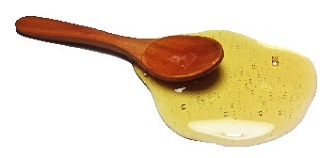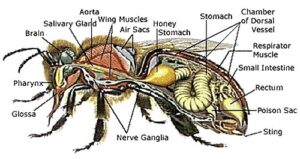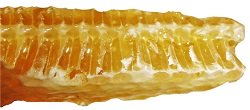bee vomit
Honey is Bee Vomit, Legit? Absolutely Not, Honeybee has 2 Stomachs!
Is is really true that honey is bee vomit?
Some people asked why this has never been mentioned in the website and that they would never eat the vomit of bees.

Honey is not bee vomit. It is perceived as vomit as it comes out from the bee’s mouth. But it is not. The bee sucks and collects the nectar from flowers using its long proboscis and store it in its special stomach or “honey stomach” separate from its true stomach for digestion. It then secretes enzymes into the nectar, converting it into honey that has healing properties.
Look at the image below, the bee has two stomachs. Honey is made and stored in a special, exclusive, and relatively big reservoir!
Honey Bee Anatomy

The bee makes this special stomach a precious sweet liquid that can never be replicated in the most advanced laboratories. I always believe this:
“The best labs can create synthetic liquids that look and taste like real honey and even have the same glucose-fructose molecular structure, but NEVER can they fake something that works the same as real honey for our health and well-being. Because the bees have added a MYSTERIOUS GOODNESS of their own that can never be comprehended by the most ingenious mind or counterfeited by the most advanced technology.”
Other Related Pages on Bee Vomit
1. Do bees poop in the honey they make? Are their droppings smelly when all they eat is honey and pollen? What do honey bees use to make the bee hive? Is it true that the government is using bees to sniff out bombs? Get these answers and fun facts of honey bee in Bee & Honey Questions Answered.
2. Learn about this little busy creature’s extraordinary abilities: 20 Wonderful Honey Bee Facts (#8 is Surprising).
3. Be amazed by how honey bees organize themselves and assume the different roles in the hive. There is every reason why the bees are known a superorganism! More facts of honey bee in: Awesome Roles of Bees in a Hive.
4. Pam is from Ohio, North America. Just started keeping bees not too long ago, she was enthusiastic to share about her new found passion – “The more we read about these amazing insects, the more respect I gained for them. I go out to our hives just to watch them come in from foraging and watch the others take flight to get the nectar and pollen.” Read full account in Insights into Beekeeping: An Interview with a Beekeeper.
5. Beekeeper Geoff Kipps-Bolton from San Diego believes that “no matter how many books you read…, the bees will retain the right to do something different…They have an infinite capacity to make you look foolish…they don’t read the same books! Read full account in An Up-Close Look at the Bees with Geoff the Beekeeper.

6. As you collect more honey bee facts and know more about honey and its benefits, there are specific terms that you would inevitably come across, such as the following:
* Bee Pollen
* Bee Wax
* Beeswax Candles
* Royal Jelly
* Propolis
* Organic Honey
* Mead
7. Meet Diniy, a young beekeeper from Selangor, Malaysia. His bees belong to the rare species of Trigona Itama, one of the many stingless bee types. They are known as Kelulut in Malaysia and “sugar bag” in Australia by the aboriginals. Learn more in: Stingless Bees are an Eye Opener.
8. Little ‘lectures’ and demonstrations by Superbee, in response to the question ‘How is Honey Made?’ during a group tour in Goldcoast, Australia: How do Bees Make Honey?